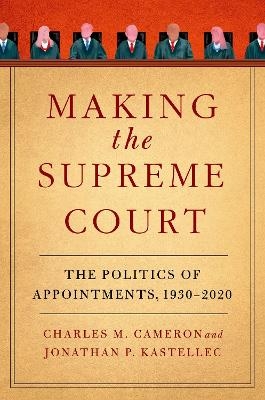
Making the Supreme Court
Oxford University Press Inc (Verlag)
978-0-19-768054-4 (ISBN)
In Making the Supreme Court, Charles M. Cameron and Jonathan P. Kastellec examine 90 years of American political history to show how the growth of federal judicial power from the 1930s onward inspired a multitude of groups struggling to shape judicial policy. Over time, some groups moved beyond lobbying the Court to changing who sits on it. Other groups formed expressly to influence appointments. These activists and organized groups penetrated the national party system so that after about 1980, presidential candidates increasingly pledged to select and confirm nominees who conformed to specific policy and ideological litmus tests. Once in office, these presidents re-shaped the executive selection system to deliver on their promises. Moreover, the selection process for justices turned into media events, often fueled by controversy. As Cameron and Kastellec argue, the result is a new politics aimed squarely at selecting and placing judicial ideologues on the Court. They make the case that this new model gradually transformed how the Court itself operates, turning it into an ideologically driven and polarized branch. Based on rich data and qualitative evidence, Making the Supreme Court provides a sharp lens on the social and political transformations that created a new American politics.
Charles M. Cameron is Professor of Politics and Public Affairs at Princeton University. He specializes in the analysis of political institutions, particularly courts and law, the American presidency, and legislatures. The author of numerous articles in leading journals of political science, he is also the author of Veto Bargaining: Presidents and the Politics of Negative Power, which won the American Political Science Association's Richard F. Fenno Jr. Prize and the William H. Riker Award. He was inducted in the American Academy of Arts and Sciences in 2014. Jonathan P. Kastellec is Professor of Politics at Princeton University. His research and teaching interests are in American political institutions, with a particular focus on judicial politics and the politics of Supreme Court nominations and confirmations. His research has been published in the American Political Science Review; American Journal of Political Science; Journal of Politics; Journal of Law, Economics & Organization; Journal of Empirical Legal Studies; and Political Research Quarterly.
I. What Happened
Then and Now
The Party Demands: Party Agendas for the Supreme Court
Selecting How to Select: Presidents and Organizational Design
The Candidates for the Court and the Nominees
Interest Groups
The Media, co-authored with Leeann Bass and Julian Dean
Public Opinion
Decision in the Senate
II. Why it Happened
The Logic of Presidential Selection, co-authored with Lauren Mattioli
What the Public Wanted
Voting in the Shadow of Accountability: Senators' Confirmation Decisions
III. How It Matters, and What the Future Holds
New Politics, New Justices, New Policies: The Courts That Politics Made
The Future: The Courts that Politics May Make
What Future Do We Want? Evaluating Judicial Independence
Conclusion
| Erscheinungsdatum | 05.08.2023 |
|---|---|
| Verlagsort | New York |
| Sprache | englisch |
| Maße | 234 x 157 mm |
| Gewicht | 644 g |
| Themenwelt | Sozialwissenschaften ► Politik / Verwaltung ► Politische Systeme |
| Sozialwissenschaften ► Politik / Verwaltung ► Staat / Verwaltung | |
| Sozialwissenschaften ► Politik / Verwaltung ► Vergleichende Politikwissenschaften | |
| ISBN-10 | 0-19-768054-2 / 0197680542 |
| ISBN-13 | 978-0-19-768054-4 / 9780197680544 |
| Zustand | Neuware |
| Haben Sie eine Frage zum Produkt? |
aus dem Bereich


